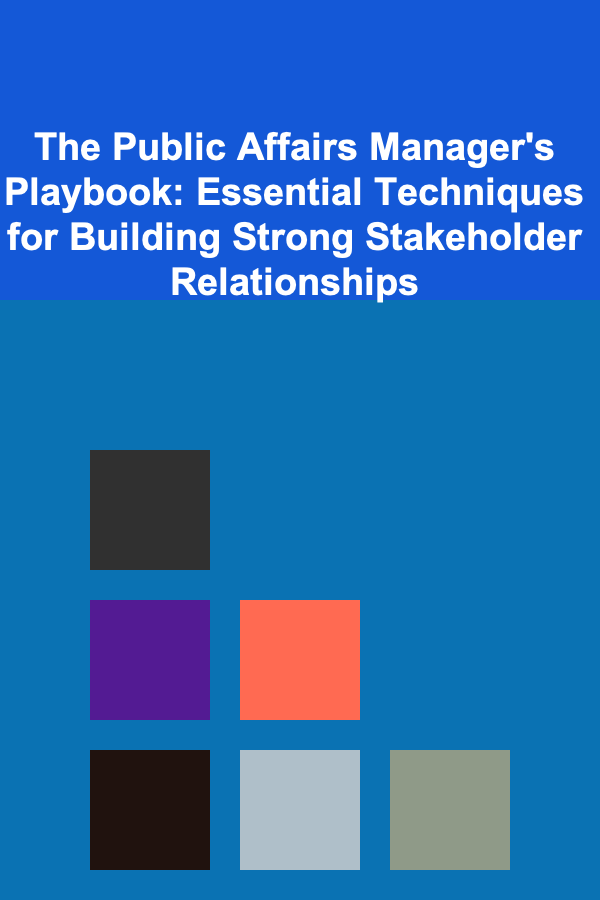
The Public Affairs Manager's Playbook: Essential Techniques for Building Strong Stakeholder Relationships
ebook include PDF & Audio bundle (Micro Guide)
$12.99$7.99
Limited Time Offer! Order within the next:

Public affairs managers are at the forefront of managing an organization's interactions with key stakeholders. Whether those stakeholders are internal or external, government officials, media, the public, or other influential groups, a public affairs manager's role is critical in shaping and maintaining the reputation of the organization. Strong stakeholder relationships are not just about navigating immediate issues, but building long-term trust and mutual understanding. This actionable guide provides essential techniques and strategies to help public affairs managers foster effective relationships and achieve positive outcomes.
Understanding Stakeholders and Their Needs
Before diving into relationship-building strategies, it is crucial to understand who your stakeholders are, what their needs are, and how they influence your organization. Different stakeholders will have different interests, concerns, and expectations. Here's how to analyze and segment stakeholders:
a. Identifying Key Stakeholders
Stakeholders in public affairs typically fall into several broad categories:
- Internal stakeholders: Employees, leadership, and board members.
- External stakeholders: Media, government bodies, customers, local communities, advocacy groups, investors, and business partners.
Identifying who your primary stakeholders are is the first step toward developing effective strategies for engagement. Stakeholders can be classified based on their influence and interest, which can help determine the level of focus and engagement required.
b. Stakeholder Mapping
Stakeholder mapping is a visual or analytical tool to identify key players and their potential influence on your organization. This process helps determine:
- Their level of influence: Are they key decision-makers? Do they have significant sway in the community or industry?
- Their interests and concerns: What are they most concerned about? Are they focused on regulatory issues, corporate social responsibility, or financial performance?
- Their potential impact: How much influence do they have on the organization's goals and reputation?
By creating a stakeholder map, you can prioritize your efforts and determine the appropriate level of engagement with each group.
Developing a Communication Strategy
Effective communication is at the heart of every successful public affairs campaign. A well-crafted communication strategy ensures that your message is clear, consistent, and reaches the right people. Here are some techniques for creating an effective communication plan:
a. Tailor Your Message to Your Audience
Each stakeholder group has distinct needs, interests, and communication preferences. For example, while government regulators may respond best to formal reports and meetings, the general public might engage more with social media posts and interactive campaigns. To ensure that your message resonates:
- Segment your audience: Understand the different types of stakeholders and segment them according to their needs and expectations.
- Craft targeted messages: Customize your message based on the concerns and interests of each group. For instance, if your goal is to build trust with investors, emphasize financial performance and corporate governance. If your goal is to engage with local communities, focus on social responsibility and environmental impacts.
- Maintain consistency: Consistency in messaging builds credibility. While the specifics of each message may vary, the overall tone, values, and goals should remain the same across all stakeholder groups.
b. Choose the Right Channels
Effective communication isn't just about the message---it's also about the medium. The appropriate communication channels depend on your stakeholders. Here are a few key channels to consider:
- Traditional media: Newspapers, TV, and radio are still powerful tools for reaching a broad audience.
- Digital media: Websites, social media platforms, email newsletters, and webinars are critical for reaching tech-savvy stakeholders.
- Face-to-face interactions: While digital tools are important, personal relationships can be just as effective, especially when dealing with high-stakes issues or top-level stakeholders. Town halls, briefings, and one-on-one meetings can help create deeper connections.
c. Crisis Communication
Crisis situations require rapid response and clarity. A key part of public affairs management is handling communication during crises. It's important to have a pre-established crisis communication plan that includes:
- Prepared statements: Have generic templates ready for different types of crises, ensuring that your organization can respond quickly.
- Transparency and honesty: Stakeholders expect openness during crises. Provide as much information as possible, even when it's not yet complete, and update stakeholders regularly.
- A single point of contact: Assign one spokesperson to ensure consistency in messaging and to prevent confusion.
Building and Nurturing Relationships
Stakeholder relationships are not just transactional; they are built on trust, understanding, and ongoing engagement. Building lasting relationships requires dedication and proactive engagement. Here are some techniques to help you build and nurture strong relationships with key stakeholders:
a. Listening Actively
Active listening is one of the most powerful tools in relationship building. It involves not only hearing the words your stakeholders say but understanding their concerns and motivations. By listening actively, you can tailor your responses and actions to meet their needs. Here's how to improve your active listening:
- Give your full attention: Focus on the speaker without distractions.
- Ask open-ended questions: Encourage stakeholders to share more by asking questions like, "What are your primary concerns?" or "How do you see our relationship evolving?"
- Clarify and summarize: Repeat or paraphrase what you've heard to ensure understanding.
b. Be Transparent and Authentic
Honesty and openness go a long way in fostering trust. Be transparent about your organization's goals, challenges, and decisions. Acknowledge mistakes when they occur and demonstrate how your organization is working to address them. Stakeholders value authenticity, and when they feel that an organization is genuine in its dealings, they are more likely to support it.
c. Provide Value and Offer Solutions
Building relationships is not just about talking; it's about adding value. Show your stakeholders that you are committed to their well-being and success by providing them with relevant information, support, and solutions. For example:
- Offer expertise: Share insights, data, or resources that can help stakeholders solve problems or make better decisions.
- Create win-win situations: Find ways that your organization and its stakeholders can benefit from working together. This might include offering partnerships, co-branding opportunities, or supporting initiatives that align with their values.
- Follow through: Be consistent in your promises. If you commit to taking an action, ensure that you follow through. Demonstrating reliability is key to maintaining trust.
Measuring Success and Adjusting Strategies
It's not enough to build relationships and communicate effectively; you must also measure the impact of your efforts and adjust your strategies accordingly. Here's how you can do that:
a. Set Clear Objectives and KPIs
Establish clear objectives for your public affairs initiatives. These could be increasing media coverage, improving community relations, or enhancing government partnerships. Identify key performance indicators (KPIs) that can measure your success, such as:
- Media mentions or sentiment analysis
- Social media engagement
- Survey results from stakeholders
- The number of partnerships or collaborations formed
- Feedback from key stakeholders (e.g., government officials, business partners)
b. Regular Feedback Loops
Feedback is essential for improving relationships. Conduct regular surveys, interviews, or informal check-ins with your stakeholders to assess their level of satisfaction, concerns, and feedback on your organization's efforts. This will allow you to:
- Gauge how well your communication is resonating.
- Identify areas where you need to improve.
- Stay ahead of potential issues before they escalate.
c. Adjust Strategies Based on Data
Once you've gathered feedback and assessed your progress against KPIs, it's important to make adjustments where necessary. For example:
- If certain messaging doesn't resonate with your stakeholders, consider refining your approach or testing alternative communications strategies.
- If stakeholders express concerns about specific issues, be proactive in addressing them through new initiatives or improvements.
Building a Long-Term Strategy
Stakeholder relationships are not one-time interactions but ongoing processes. To ensure long-term success, consider these strategies:
a. Engage in Continuous Education
Stay informed about the evolving interests and concerns of your stakeholders. This could mean attending industry conferences, participating in forums, and regularly reviewing public sentiment. Staying ahead of trends allows you to anticipate stakeholder concerns before they arise.
b. Cultivate a Culture of Engagement
Make stakeholder engagement a core value within your organization. This can be achieved by:
- Encouraging leadership to engage with key stakeholders.
- Implementing cross-departmental collaboration on stakeholder-related initiatives.
- Ensuring that public affairs managers have the support they need to engage with stakeholders effectively.
c. Develop Long-Term Partnerships
Rather than focusing solely on short-term objectives, aim to build long-term partnerships with stakeholders. Foster relationships that are mutually beneficial and that evolve over time. By doing so, you ensure that your organization has a robust network of supporters who are invested in your success.
Conclusion
Public affairs management is a multifaceted, strategic role that requires a deep understanding of stakeholder dynamics, effective communication, and the ability to build and maintain long-term relationships. By employing thoughtful techniques such as active listening, transparent communication, and targeted engagement strategies, public affairs managers can foster positive, lasting relationships with stakeholders that benefit both the organization and its broader community.
Reading More From Our Other Websites
- [Hiking with Kids Tip 101] Best Rain‑Ready Trail Hikes for Families with Small Kids in the Pacific Northwest
- [Home Budget 101] How to Categorize Your Household Budget: Essential Categories for Tracking Your Spending
- [Home Pet Care 101] How to Socialize Your Pet in a Home Environment
- [Organization Tip 101] How to Use Checklists to Manage Day-to-Day Tasks
- [Beachcombing Tip 101] Tidal Treasures: Timing the Tide for the Best Finds
- [Ziplining Tip 101] Lighting the Skyline: Best Times of Day to Photograph Ziplining Adventures
- [Home Space Saving 101] How to Downsize Your Belongings Without Feeling Overwhelmed
- [Organization Tip 101] Top Lighting Products for Improving Visibility for Low Vision
- [Home Space Saving 101] How to Store Your Kids' Toys Without Taking Over the House
- [Personal Care Tips 101] How to Use Body Spray for Confidence During Public Speaking

Building Bridges: Effective Communication Skills for Executive Assistants
Read More
How to Improve Website Content Readability for Better UX
Read More
How to Tidy Up Your Bedroom and Keep It Organized
Read More
How to Train Your Pet for Better Behavior and Bonding
Read More
How to Create a Consistent Cartoon Style
Read More
10 Tips for Perfect Vegan Indian Cooking
Read MoreOther Products

Building Bridges: Effective Communication Skills for Executive Assistants
Read More
How to Improve Website Content Readability for Better UX
Read More
How to Tidy Up Your Bedroom and Keep It Organized
Read More
How to Train Your Pet for Better Behavior and Bonding
Read More
How to Create a Consistent Cartoon Style
Read More